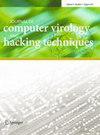生成对抗网络和基于图像的恶意软件分类
IF 1.9
Q3 COMPUTER SCIENCE, INFORMATION SYSTEMS
Journal of Computer Virology and Hacking Techniques
Pub Date : 2023-02-13
DOI:10.1007/s11416-023-00465-2
引用次数: 2
摘要
为了有效地清除恶意软件,确定恶意软件的威胁级别和估计损害,恶意软件家族分类起着至关重要的作用。在本文中,我们从恶意软件可执行文件中提取特征,并使用各种方法将其表示为图像。然后,我们将重点放在多类分类的生成对抗网络(GAN)上,并将我们的GAN结果与其他流行的机器学习技术进行比较,包括支持向量机(SVM)、XGBoost和受限玻尔兹曼机(RBM)。我们发现AC-GAN鉴别器通常与其他机器学习技术竞争。我们还评估了GAN生成模型在基于图像的恶意软件检测中的对抗性攻击的效用。虽然AC-GAN生成的图像在视觉上令人印象深刻,但我们发现使用几种学习技术中的任何一种都很容易将它们与真实的恶意软件图像区分开来。这一结果表明,我们的GAN生成的图像在对抗性攻击中几乎没有价值。本文章由计算机程序翻译,如有差异,请以英文原文为准。
Generative adversarial networks and image-based malware classification
For efficient malware removal, determination of malware threat levels, and damage estimation, malware family classification plays a critical role. In this paper, we extract features from malware executable files and represent them as images using various approaches. We then focus on generative adversarial networks (GAN) for multiclass classification and compare our GAN results to other popular machine learning techniques, including support vector machine (SVM), XGBoost, and restricted Boltzmann machines (RBM). We find that the AC-GAN discriminator is generally competitive with other machine learning techniques. We also evaluate the utility of the GAN generative model for adversarial attacks on image-based malware detection. While AC-GAN generated images are visually impressive, we find that they are easily distinguished from real malware images using any of several learning techniques. This result indicates that our GAN generated images are of surprisingly little value in adversarial attacks.
求助全文
通过发布文献求助,成功后即可免费获取论文全文。
去求助
来源期刊

Journal of Computer Virology and Hacking Techniques
COMPUTER SCIENCE, INFORMATION SYSTEMS-
CiteScore
4.00
自引率
13.30%
发文量
41
期刊介绍:
The field of computer virus prevention has rapidly taken an important position in our technological and information society. Viral attacks increase year after year, and antiviral efforts continually face new challenges. Beneficial applications of technologies based on scientific computer virology are still very limited. The theoretical aspects of the virus problem are only rarely considered, although many interesting and important open problems still exist. Little proactive research is focused on predicting the future of viral attacks.The Journal of Computer Virology and Hacking Techniques is an independent scientific and technical journal dedicated to viral and antiviral computer technologies. Both theoretical and experimental aspects will be considered; papers emphasizing the theoretical aspects are especially welcome. The topics covered by this journal include, but are certainly not limited to:- Mathematical aspects and theoretical fundamentals of computer virology - Algorithmics and computer virology - Computer immunology and biological models for computers - Reverse engineering (hardware and software) - Viral and antiviral technologies - Cryptology and steganography tools and techniques - Applications in computer virology - Virology and IDS - Hardware hacking, and free and open hardware - Operating system, network, and embedded systems security - Social engineeringIn addition, since computational problems are of practical interest, papers on the computational aspects of computer virology are welcome. It is expected that the areas covered by this journal will change as new technologies, methodologies, challenges and applications develop. Hacking involves understanding technology intimately and in depth in order to use it in an operational way. Hackers are complementary to academics in that they favour the result over the methods and over the theory, while academics favour the formalization and the methods -- explaining is not operating and operating is not explaining. The aim of the journal in this respect is to build a bridge between the two communities for the benefit of technology and science.The aim of the Journal of Computer Virology and Hacking Techniques is to promote constructive research in computer virology by publishing technical and scientific results related to this research area. Submitted papers will be judged primarily by their content, their originality and their technical and scientific quality. Contributions should comprise novel and previously unpublished material.However, prior publication in conference proceedings of an abstract, summary, or other abbreviated, preliminary form of the material should not preclude publication in this journal when notice of such prior or concurrent publication is given with the submission. In addition to full-length theoretical and technical articles, short communications or notes are acceptable. Survey papers will be accepted with a prior invitation only. Special issues devoted to a single topic are also planned.The policy of the journal is to maintain strict refereeing procedures, to perform a high quality peer-review of each submitted paper, and to send notification to the author(s) with as short a delay as possible. Accepted papers will normally be published within one year of submission at the latest. The journal will be published four times a year.
Note: As far as new viral techniques are concerned, the journal strongly encourages authors to consider algorithmic aspects rather than the actual source code of a particular virus. Nonetheless, papers containing viral source codes may be accepted provided that a scientific approach is maintained and that inclusion of the source code is necessary for the presentation of the research. No paper containing a viral source code will be considered or accepted unless the complete source code is communicated to the Editor-in-Chief. No publication will occur before antiviral companies receive this source code to update/upgrade their products.The final objective is, once again, proactive defence.This journal was previously known as Journal in Computer Virology. It is published by Springer France.
 求助内容:
求助内容: 应助结果提醒方式:
应助结果提醒方式:


